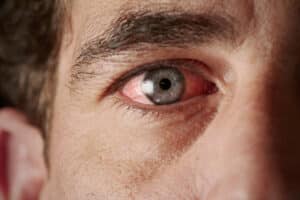It’s no mystery that our eyes play a pivotal role in our lives. They also happen to be some of our most sensitive organs. So when a sharp pain in your eye starts to creep up on you, it’s a cause for concern—let alone extremely uncomfortable. In these situations, you immediately worry and ask yourself “Where did this sharp pain come from?”
A sharp pain in your eye is not to be ignored, it’s important to address it quickly. Our team at the Cleveland Eye Clinic would like to extend our helping hand to guide you in this process. We’ll break down the possible causes and when it’s a necessary time to get a doctor involved. Your eye health is important, and that’s why providing you with helpful resources is beneficial for the future of your eyes.
Reasons You Might Feel a Stabbing Pain In Your Eye
A stabbing pain in your eye could be the result of several different causes. These are some common reasons you may be experiencing sharp pain in your eye:
Debris or Foreign Object in the Eye
Debris such as dirt or dust and the presence of a foreign object like a tiny piece of glass can cause a sharp pain in your eye. You can flush your eye with water or saline if you think there is something in your eye.
Corneal Abrasions
A scratch or damage on the cornea of the eye, the outermost layer, is another common reason for sharp pain in the eye. This is specifically called a “corneal abrasion.” Corneal abrasions can be caused by the presence of debris or foreign objects in the eye.
Thankfully, minor abrasions heal within days. Avoid rubbing your eyes if you believe or know you have an abrasion to avoid further damage. Lubricating eye drops or antibiotic ointments can also help the healing process.
Eye Infections 
Multiple types of eye infections can lead to sharp pains in the eyes. Keratitis, herpes, and conjunctivitis are prime cases. Alongside sharp eye pain, eye infections can also cause symptoms such as:
- Watering
- Redness
- Swollen eyes
- Light sensitivity
- Discharge (watery or yellow-green pus)
Antibiotic eye drops are a great solution in case of an eye infection. These eye drops will typically clear up the infection after three days.
Contact Lens Issues
Contact lenses that get caught, lost, or lodged are also known for causing a sharp pain in the eye. Here are some ways to help prevent contact lens issues:
- Visit the eye doctor once a year for an exam and fitting
- Avoiding sleeping with contact lenses
- Take out contact lenses every once in a while to give your eyes a break
- Follow the instructions from your eye doctor
- Lubricate your eyes with resetting drops
- Clean and store your contact lenses correctly
- Change your contact lenses when they need to be changed and don’t overwear them
With these practices in mind, the chance of your contact lenses causing pain in your eyes is not nearly as high.
Dry Eye 
The human eye has three layers of tear film over it to help with vision and keep it clean. A watery layer, an oily layer, and a mucus layer. The eye will produce tears to help keep them moist. Crying a lot, medication side effects, medical conditions, and aging can cause the eyes to dry out. Dry eyes can lead to a sharp pain and other symptoms like:
- Stinging or burning sensation
- Redness and irritation
- Mucus around the eyes
- Pain when putting contact lenses in
- A gritty feeling
Treatment-wise, TearCare is a personalized and open-eye procedure that clears up any blockages that result in dry eye discomfort. Schedule a dry eye evaluation with us today to determine if this procedure can help alleviate your dry eye discomfort.
Uveitis 
Uveitis is the inflammation of the middle layer of the eye, known as the uvea. Uveitis can happen in one or both eyes. Common symptoms associated with uveitis include:
- Eye pain
- Redness
- Dark spots in a person’s vision
- Blurred vision
- Sensitivity to light
Damaged tissue in the eye due to uveitis can result in reduced vision or vision loss.
Glaucoma
Glaucoma is an eye condition associated with increased pressure inside the eye. There are multiple types of glaucoma. This eye condition can lead to damage to the optic nerve and potential vision loss.
Angle-Closure glaucoma. Angle-closure glaucoma is an acute glaucoma that develops rapidly and can cause sudden stabbing pain in the eye. This type of glaucoma is a medical emergency. Seek immediate medical attention if you believe you have angle-closure glaucoma.
Open-angle glaucoma. Open-angle glaucoma is the most common type of glaucoma. This type can lead to added pressure in the eye and can lead to blindness if it isn’t treated.
Neovascular glaucoma. This type of glaucoma develops when the eye produces extra blood vessels that cover the area of the eye where fluid normally drains. Commonly the result of another medical disease, such as diabetes or high blood pressure, neovascular glaucoma is another form of glaucoma that may cause eye pain.
Uveitic glaucoma. This is a type of glaucoma that is a direct result of having uveitis. It can cause eye pain and swelling.
Available treatments for glaucoma involve medications to lower intraocular pressure. Laser or surgical procedures are sometimes also an option to relieve the pressure. Routine eye exams are of the utmost importance for diagnosing eye conditions like glaucoma and finding the correct treatment.
When Should I Contact A Doctor About Sharp Eye Pain?
Contact your doctor or ophthalmologist if you are experiencing these symptoms:
- Severe eye pain
- Eye pain that does not go away after a few hours
- Visual disturbances, such as blurred vision or dark spots
- Visible swelling of the eye
- Nausea or vomiting
If these apply to you, contact us today to book an appointment. We’ll diagnose the root cause of the sharp pain in your eyes and find the perfect solution.








